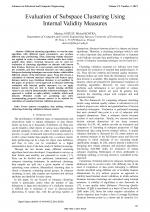| 3/2015 - 20 |
Evaluation of Subspace Clustering Using Internal Validity MeasuresOSZUST, M. |
| Extra paper information in |
| Click to see author's profile in |
| Download PDF |
Author keywords
pattern recognition, data mining, subspace clustering, clustering validation, distance metrics
References keywords
clustering(19), data(13), information(9), subspace(8), algorithms(7), measures(6), machine(6), evaluation(6), systems(5), review(5)
Blue keywords are present in both the references section and the paper title.
About this article
Date of Publication: 2015-08-31
Volume 15, Issue 3, Year 2015, On page(s): 141 - 146
ISSN: 1582-7445, e-ISSN: 1844-7600
Digital Object Identifier: 10.4316/AECE.2015.03020
Web of Science Accession Number: 000360171500020
SCOPUS ID: 84940728824
Abstract
Different clustering algorithms, or even the same algorithm with different input parameters, can produce different data partitioning. Then, clustering validity measures are applied in order to determine which results have better quality than others. External measures can be used for evaluation of clustering algorithms on datasets with known data division. However, in a real scenario such information is not available, and here internal measures are often applied. Subspace clustering techniques can create clusters which utilise different subsets of the full feature space. From this reason, a calculation of internal measures using the full feature space distance metrics (e.g., Euclidean distance) is not justified. In this paper, we propose a novel approach to subspace clustering evaluation with internal quality measures, i.e., we apply distance metrics that are able to handle missing attribute values or are used in dimensionality reduction techniques. Our approach is verified on eight publicly available, widely-used datasets. Obtained results are promising and allow recommending proposed distance metrics to be suitable for calculation of examined internal validation measures. |
| References | | | Cited By |
Web of Science® Times Cited: 2 [View]
View record in Web of Science® [View]
View Related Records® [View]
Updated today
SCOPUS® Times Cited: 2
View record in SCOPUS® [Free preview]
View citations in SCOPUS® [Free preview]
[1] Customized decision tree-based approach for classification of soil on cloud environment, Shastry, K. Aditya, Sanjay, H. A., Computing, ISSN 0010-485X, Issue 6, Volume 105, 2023.
Digital Object Identifier: 10.1007/s00607-022-01144-8 [CrossRef]
[2] Understanding and Enhancement of Internal Clustering Validation Indexes for Categorical Data, Gao, Xuedong, Yang, Minghan, Algorithms, ISSN 1999-4893, Issue 11, Volume 11, 2018.
Digital Object Identifier: 10.3390/a11110177 [CrossRef]
Disclaimer: All information displayed above was retrieved by using remote connections to respective databases. For the best user experience, we update all data by using background processes, and use caches in order to reduce the load on the servers we retrieve the information from. As we have no control on the availability of the database servers and sometimes the Internet connectivity may be affected, we do not guarantee the information is correct or complete. For the most accurate data, please always consult the database sites directly. Some external links require authentication or an institutional subscription.
Web of Science® is a registered trademark of Clarivate Analytics, Scopus® is a registered trademark of Elsevier B.V., other product names, company names, brand names, trademarks and logos are the property of their respective owners.
Faculty of Electrical Engineering and Computer Science
Stefan cel Mare University of Suceava, Romania
All rights reserved: Advances in Electrical and Computer Engineering is a registered trademark of the Stefan cel Mare University of Suceava. No part of this publication may be reproduced, stored in a retrieval system, photocopied, recorded or archived, without the written permission from the Editor. When authors submit their papers for publication, they agree that the copyright for their article be transferred to the Faculty of Electrical Engineering and Computer Science, Stefan cel Mare University of Suceava, Romania, if and only if the articles are accepted for publication. The copyright covers the exclusive rights to reproduce and distribute the article, including reprints and translations.
Permission for other use: The copyright owner's consent does not extend to copying for general distribution, for promotion, for creating new works, or for resale. Specific written permission must be obtained from the Editor for such copying. Direct linking to files hosted on this website is strictly prohibited.
Disclaimer: Whilst every effort is made by the publishers and editorial board to see that no inaccurate or misleading data, opinions or statements appear in this journal, they wish to make it clear that all information and opinions formulated in the articles, as well as linguistic accuracy, are the sole responsibility of the author.



